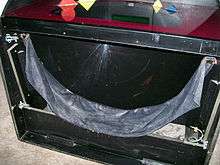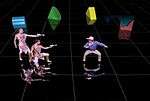Time Traveler (video game)
| Hologram Time Traveler | |
|---|---|
 Title logo | |
| Developer(s) | Virtual Image Productions (arcade), GTE Interactive Media (arcade/PC/DVD) |
| Publisher(s) | Arcade published by Sega, PC/DVD by Digital Leisure |
| Designer(s) | Rick Dyer, engine: David Salizzoni (arcade). David Foster, Calvin Lee (DVD), arcade optics: Steve Zuloff and Barry Benjamin |
| Platform(s) | Arcade game |
| Release date(s) |
1991 (arcade) 2001 (home) |
| Genre(s) | FMV game |
| Mode(s) | Single player |
| Arcade system | Sega Laserdisc |
| CPU | Zilog Z80 |
| Display | Hitachi-Sega VIP-9500SG laserdisc player |
Time Traveler or Hologram Time Traveler is a stereographic laserdisc FMV arcade game released in 1991 by Sega and designed by Dragon's Lair creator Rick Dyer. It is called the "World's First Holographic Video Game"[1] because it uses a special arcade cabinet that projects the game's characters. The "holographic" effect is an optical illusion using a large curved mirror and a CRT television set.
The game's premise is that American old west cowboy Marshal Gram (played by Stephen Wilber, also hired to coordinate the game's stunts) is required to save the universe from scientist turned evil time lord Vulcor, who's found a way to manipulate and distort time itself; and to also rescue Princess Kyi-La of the Galactic Federation, whom Vulcor is holding prisoner in his quest to disrupt the flow of time. The player must pursue the villain across time through the ages overcoming various obstacles along the way while undoing all the damage done by Vulcor. The game's action sequences were filmed in San Diego, California, with forty actors and a small production crew of about five people headed by Producer/Director Mark E. Watson of Fallbrook California.[1] The game takes place across many iconic settings from different time periods. All the game's footage was shot as if it were a live action movie. Few props were used during filming as the actors had to imagine fantastical locations while being filmed in front of a green screen stage. Some actors performed multiple roles, for example, the same actor played the obese "amazon queen" in the bonus DVD features and a chainsaw-wielding character in the game. The game's special effects, music and character voices were later added at a special effects studio in Carlsbad, California.
In 2001, a non-stereographic version was published by Digital Leisure in PC CD-ROM and standard DVD format.
Console design

The game uses a special arcade cabinet that projects the game's characters using reflection, making them appear free-standing. The "holographic" effect is an optical illusion using a large curved mirror and a CRT television set. Characters appear as tiny images about five inches (12.7 cm) tall, standing in mid-air in a manner similar to the volumetric projections seen in the Star Wars movies.
Time Traveler has a non-standard shape for an upright arcade cabinet. Though the game is played standing up the cabinet is larger and shorter resembling an oversized cocktail design (50"Hx43"Wx45"D) (H: 127 cm; W: 109.2 cm; D: 114.3 cm). It doesn't have a monitor but instead uses a flat, dark stage called the "Micro-theater",[1] which was invented by engineers Steve Zuloff and Barry Benjamin. The Micro-theater is composed of a big concave mirror that lies underneath the stage. Along with it, a 20 inch (50.8 cm) Sony TV sits in front of the mirror. The player controls are located on top of the TV equipment. A couple of neon colored geometric blocks placed at the back of the stage serves as the only background for the game. It is decorated with white formica all around and with a tall "SEGA Hologram Time Traveler" sign on its back.
 TV set inside the cab.
TV set inside the cab. Hologram Time Traveler arcade cabinet
Hologram Time Traveler arcade cabinet
Gameplay

Time Traveler's gameplay is similar to Dragon's Lair. The player moves a joystick in a specific direction or presses a button at certain points in the game. By entering the right command, a movie clip plays showing the player's character progression through the game, while the wrong move results in a unique death scene for each segment. Time Traveler is different from Dragon's Lair by offering lots of supportive help. For example, the game shows hints through a short video clip after losing a life. It also offers a short tutorial available at the beginning of the game.
The player controls consist of a 4-way joystick, an action button and a time reversal button. The latter is a feature that allows the player to rewind and repeat the last couple of seconds of a failed segment. This gives the player a second chance to try and escape his death without having to repeat the complete FMV sequence all over again. Between levels, players can buy more time-reversal cubes by inserting more coins into the arcade machine.
The game starts with three lives and one time-reversal cube. Gameplay keeps going until the player loses all of their lives or completes the game. It also encourages players to insert more coins by allowing continues and the option to purchase additional time reversal cubes. Being an arcade game, it is designed with a hard difficulty setting and for short gameplay time. Assuming the player successfully memorizes the majority of the FMV sequences, then the game takes about ten minutes to complete.
Time Traveler offers a total of seven levels called "time periods". Every level has a time era theme (e.g. pre-historic, Middle Ages, the future) except one fictional one represented by symbols called the Age of Magic. Time periods consists of a number of FMV sequences, usually three. Completion or failure of a level returns the player back to the level menu. To minimize repetition the game randomizes the order FMV sequences play within a level. It also allows the player to choose the order in which to play the time periods up to a certain degree. Later time periods are not accessible until the player completes a required amount of levels.
As the game progresses players randomly encounter a mini-game called "Hellgate". In this mini-game the player can bet a life to win extra lives or even a free credit. The game consists of a slot machine where the mini game takes its name from. Depending on the outcome, the game awards or penalizes the player by giving or taking away lives. One of the outcomes makes the player lose the entire game, not just Hellgate. Expert arcade players usually avoid playing this game as the odds were heavily stacked against them resulting mostly with losing lives rather than winning bonuses.
DVD release
In 2001, the game was published by Digital Leisure in PC CD-ROM and standard DVD formats. These home versions have the option to simulate the mirror reflection of the original arcade cabinet through a pair of anaglyph stereoscopic glasses due to the lack of the original arcade cabinet's hardware.
As with other Digital Leisure DVD releases, the game's box advertises being "Playstation 2 [or Xbox] Compatible" on the cover to attract console owners. Bonus features include interviews with creator Rick Dyer about the making of Time Traveler, as well as some of the actors in the game. It also shows behind the scenes footage from some of the scenes without the special effects.
Differences between original arcade and DVD release
- The DVD version lacks the mirror equipment used by the arcade version to achieve its volumetric display. Instead, it includes a pair of stereoscopic 3D glasses as well as an alternate game video that adds a whirlpool-like moving background to provide an illusory stereoscopic effect.
- To simulate the actual props that were part of the arcade machine, the DVD version of Time Traveler has pre-rendered geometrical shapes inserted to the video. It also incorporates a grid-like background which was not present in the original.
- The arcade version has separate buttons for action and time reversal commands, whereas the DVD uses the same button for both.
- In the DVD version, time reversal cubes are free. In the arcade version the player has to insert more coins.
- The DVD version uses a default of 5 starting lives, whereas in the arcade version the number depended on internal settings of the arcade system.
- The arcade version uses an alphanumeric LCD to show game information like score, lives left, etc. The DVD version doesn't keep track of score, but does so for lives and time reversal cubes and shows the player's remaining lives in a still frame between levels.
- Since DVD remotes are not designed for the fast input video games require, the game's responsiveness wildly varies depending on the DVD hardware used to play it.
- The DVD version superimposes symbols which represent the action read by the remote and signals the player when to enter the next move. The real arcade game does not do this.
- The time frame for player response in the DVD version of the game is often out of sync with sequences of the video game. The original game footage gives visual cues that prompt the player's next move. The lack of sync allows insufficient time for the player to respond; the fault occurs just before the cues appear on the screen. By that time, it is too late for the player to successfully complete the move. The original arcade game does not suffer from this issue.
- The arcade applies sound beeps of different tones if a right or wrong action is selected, a standard feature in most laserdisc games. The DVD version does not.
- Vulcor's "Hellgate" mini game plays considerably more frequently in the DVD port. In the arcade version this video sequence does not appear during the beginning levels and it doesn't play as often meaning a player could complete consecutive levels without watching this sequence. In the DVD version, Vulcor's game of chance shows up early on and plays almost every time a player finishes a level.
- The DVD version has a programming bug that allows the player to skip directly to higher levels.
- The arcade version has two easter eggs: Pressing both game buttons while pressing down on the joystick with a credit on the machine shows Rick Dyer dancing around with his son on his back. Doing the same procedure while pressing up on the joystick shows the game's development team. There are video clips of production footage and interviews on the disc.
Reception and legacy
According to archived news video footage from TV stations in California, US, the game was considered a financial success for Dyer's company Virtual Image Productions and SEGA, earning an average of US$1 million per week during its peak at the arcades. The game's commercial life was not long. With fighting games such as Street Fighter and Mortal Kombat becoming extremely popular, SEGA released the game Holosseum as a conversion kit for the arcade cabinet about a year after Time Traveler's release. Dyer considered making a sequel, or adapting the technology for use in casino machines. SEGA kept their interest in the genre by publishing many FMV games on their Sega CD CD-ROM drive add-on for the Genesis home console.
The DVD version of the game was the only title to receive a 0/10 score from Official UK PlayStation 2 Magazine.
See also
References
External links
- News report on Time Traveler featuring an interview with Rick Dyer
- Time Traveler and similar games at The Interactive Movies Archive
- Time Traveler promotional flyer, courtesy of dragons-lair-project.com
- Time Traveler arcade parts, courtesy of www.game-restore.com
- Screenshots and Artwork at the official Digital Leisure site
- Time Traveler at the Killer List of Videogames
- Time Traveler at Coinop.org
- Example of the arcade machine in use